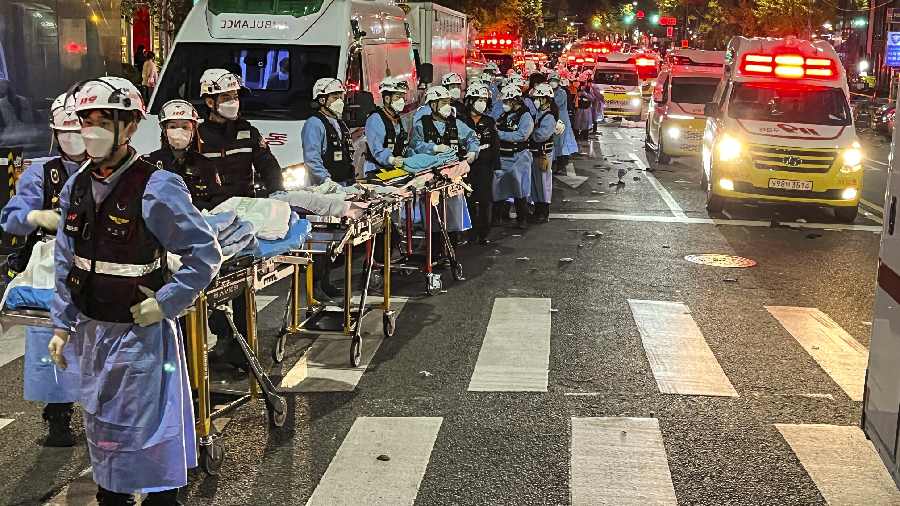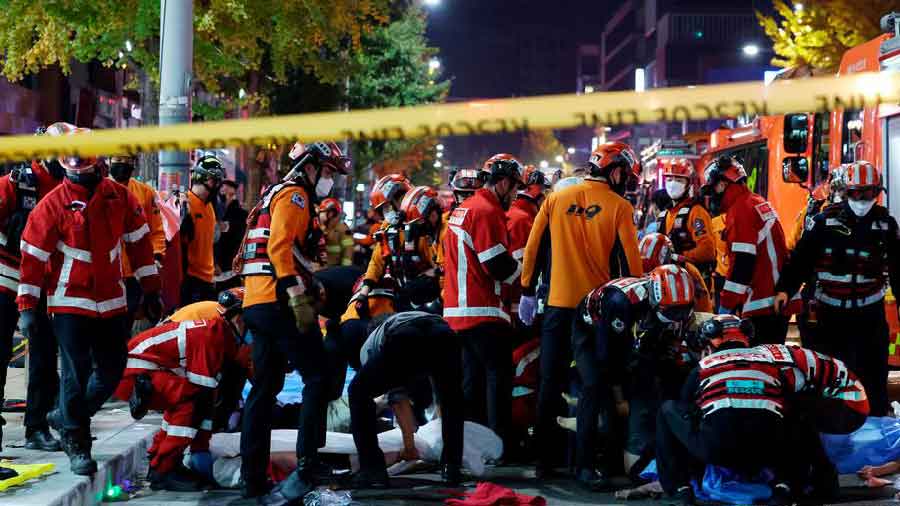A raucous Halloween celebration in the swinging center of the South Korean capital morphed Saturday night into a grim procession of bodies after at least 151 people were killed in the crush of a crowd stuck in a narrow roadway, officials said.
Dozens more were injured, many of them seriously, according to a fire department spokesperson.
As many as 100,000 people were celebrating Halloween in Itaewon, an area of central Seoul popular for its nightlife. The holiday had long been a neighborhood favorite before being interrupted by coronavirus restrictions imposed on the city two years ago, and young people flocked to parties Saturday night.
By Sunday morning, costume-clad partygoers had fled a scene strewn with the bodies of young revelers as chaos and confusion reigned. At news conferences, officials said they had no clear idea of what caused the crush, or how the annual festival had devolved so quickly into the country’s worst peacetime tragedy since 2014.
As images of lifeless bodies piled atop each other and queues of emergency workers pushing gurneys loaded with the dead circulated across social media, Koreans demanded answers and accountability.
Kim Geun-jin, a division commander for the Seoul police, said that little could be reported about the cause of the disaster as of 4 a.m. Sunday because “identifying the victims is our top priority.” He added: “Our forensic teams are focused on identifying victims and collecting evidence from the site.”
In the early hours of Sunday morning, residents congregated at hospitals and makeshift mortuaries looking for their loved ones. Most of those killed were teenagers or in their 20s, Choi said. The dead included two foreigners, added Choi, who did not specify their nationalities.
At one ad hoc mortuary, at the Wonhyoro Multipurpose Indoor Gymnasium, just west of Itaewon, the bodies of 45 young people were arrayed on the floor beneath plastic sheets. Many still wore the costumes they had donned for a night of partying, one way distraught relatives would be able to identify them.
Kim Seo-jeong, 17, a high school student who dressed in a traditional Chinese qipao to go clubbing in the area, said that by 8 p.m. the alley near the Itaewon subway station was already too crowded to walk.
“We gave up an hour later and tried to turn around to go home but we could not move in the other direction either,” Kim said in a telephone interview. “There were people pushing from behind us. There were people in front of us pushing down the hill to go in the other direction.”
Later, a group of young men made a hard shove down the hill, chanting “Push! Push!”
“A person in front of me slipped and fell, pushing me down as well. People behind me fell like dominoes,” Kim said. “There were people beneath me and people falling on top of me. I could hardly breathe. We shouted and screamed for help, but the music was so loud in the alley our shouts were drowned.”
The crush began at a narrow roadway right outside Exit 2 of the Itaewon subway station, in Itaewon, one of Seoul’s more international and freewheeling neighborhoods, near a row of bars that included, among others, Oasis Bar & Cafe, Gathering and Ravo — a blazing neon magnet for young people looking for a good time. A big sign in yellow, red, pink and blue letters read, “Happy Halloween.”
Around 11 p.m., officials began sending alerts urging people to avoid Itaewon. Benedict Manlapaz, a filmmaker visiting from New York, arrived at the station about an hour later to see the streets jammed with crowds. The people, he said, were “irritated,” with some crying.
“People were shoulder to shoulder,” said Manlapaz, 23.
Witnesses said police appeared to have trouble maintaining control of the crowds. And images posted to social media showed scores of bodies piled atop one another in the narrow alley as emergency crews worked to pull them free.
“Our people are so insensitive about public safety,” Kim said. “The government should have sent more police to control the crowd. There was a Halloween crowd in Itaewon last year despite the pandemic. The government should have anticipated a much bigger crowd this year because most of the pandemic restrictions are gone.”
Officials initially said that many of those killed had lapsed into cardiac arrest. Citizens, police officers and emergency medical workers were seen performing cardiopulmonary resuscitation on people sprawled on the pavement. Later, a grim lineup of bodies covered by sheets or towels appeared before rescue workers could begin carrying them away.
More than 800 emergency workers and police officers from around the nation, including all available personnel in Seoul, were deployed to the streets to treat the injured.
But ambulances and police vehicles struggled to make their way to and from the site, with roads jammed and pedestrians spilling into traffic.
“It was so bad we couldn’t even see the road,” said Jeong Sol, 30, of Seoul. “The crowd was so large that it had spilled off the sidewalks onto the street.”
She added: “We were shoved around a lot. People were pushed and dragged, irrespective of who they were.”
The New York Times News Service












